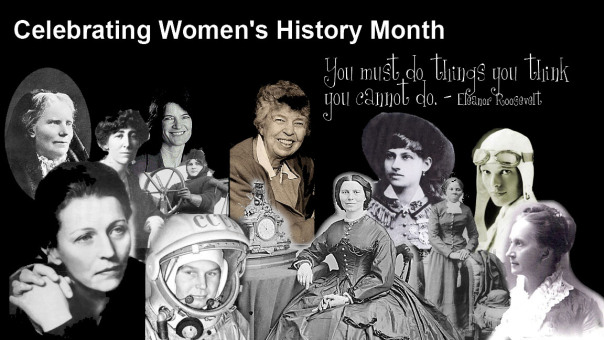
Women’s History Month honors the hard work and contributions made by women from the past and in the present. What I have found interesting in my research is the pioneering spirit, mostly through sheer force of will, where women pushed back, persevered and helped change corporate landscape. Over the years women have redefined what was possible and rejected the constraints of traditional roles. These women paved the way for me and many other successful women in business and for future generations.
Because there are many women in the workforce today that are very successful in industries such as High-Tech (think Sheryl Sanberg, Merissa Meyer, Meg Whitman) it is easy to assume that business women always easily reach high-profile positions in American business. Of course we know now that this hasn’t always been the case. The numbers of women reaching senior level positions in companies has grown very slowly from mid-century to today. I had no idea that the numbers were so low. For many years I assumed we were making great strides and I stopped paying attention to the numbers of women in senior level positions and on boards. It wasn’t until two years ago that I started to research the current status of women in business and was shocked at the news. As a woman from the baby boomer generation, and one who bought into the concept that we could achieve it all, it is clearly evident that we still need to be vigilant for the future of women in leadership positions.
A way to remain attentive to the future needs of business women is by examining the past. This enables us to put the accomplishments of women like Martha Stewart, Oprah, Indra Nooyi CEO of Pepsi or Ursula Burns CEO of XEROX in perspective. Through history, we see what connects them to women who lived long ago and helps us to continue to build on the strengths of their lessons.
Lessons from the 1900’s to now
The role of women in the American economy changes with each decade. Each new generation redefines what it means to be a female in the workforce and helps us to prepare for our next generation of successful women in the workplace. We know that the accomplishments of today’s successful businesswomen owe much to the groundwork of earlier generations of female entrepreneurs and workers. And the future generation of women will depend on our diligence to the our common cause.
Here are some lessons discovered from our predecessors and from those who are successful today.
Had a Vision
Visionaries constantly think about the future, they think about where they are going rather than where they have been. They think about the opportunities of tomorrow rather than focusing on the problems of the past. These visionary women below created products to improve the management of the home and to improve women’s personal appearance.
- Dorothy Shaver of Lord &Taylor, rose to the to the top of American retailing between the 1920s and the 1950s through a very determined effort to upgrade women’s fashions.
- Freda Diamond, named the “Designer for Everybody” by Life magazine in 1954, had a highly successful, fifty-year career as a home furnishings consultant. From the 1930s through the 1980s, Diamond helped American industries to design affordable products for the mass market.
- In the 1950s, sales executive Brownie Wise accumulated a personal fortune and made Tupperware into a household name by capitalizing on well-established traditions of women’s social networks to create Tupperware Home Parties.
Today: Martha Stewart’s hugely successful business is influenced by her predecessors and continues to help women manage home life though her Marta Stewart Living.
Courage to take risks
They really believed in their mission. They’ve built their success through sheer will and determination and of course they had the skills, intellect and they were fully committed. But they also had the desire to do something great.
It is important to stand up and really go after something. That takes courage. An example of this is Kathrine Switzer in 1967who became the first woman to run the Boston Marathon, finishing despite an attempt by a race organizer to throw her out because she was a woman.
Whatever fear they might have of hearing “no” they push through it. It’s not because they’re fearless, no one is. It’s because they have learned how to become resilient and face their fears, everyday.
Today: Mary Barra, the first female CEO of GM is confronting the kind of catastrophic oversight and subsequent scrutiny that could confound even the most weathered executives. In a courageous move, Barra affirming head-on GM’s accountability for the 12 deaths resulting from an ignition defect and announced over a three million vehicle recall.
Life Lessons Matter
As one goes through life, there are many experiences that will cause one to pause and reflect upon their journey. For example, you didn’t get the raise, or you were downsized or you were passed over for that coveted promotion. There are things that could eventually trip us up and dampen our spirit, like failure — or even the fear of failure. We forget that failure is often a necessary part of eventual success. Learn the lesson, and move on. Our life lessons serve us well.
Before starring in I Love Lucy, LucilleBall was widely regarded as a failed actress and a B movie star. Even her drama instructors didn’t feel she could make it, telling her to try another profession. She proved them all wrong.
Today: The Harry Potter’s author’ JK Rowling wrote Harry Potter and the Philosopher’s Stone (the first book in the series) as a struggling single mother on welfare and faced 12 rejections from publishers, eventually sold the book for the equivalent of $4,000. The series went on to break numerous sales records, be turned into an incredibly successful film series. J.K. Rowling is now worth an estimated $1 billion.
Resist inequality
The key for women is to resist accepting inequality by any appropriate means. Sometimes that means a face to face talk to change someone’s behavior, sometimes it means asserting your rights and sometimes it means walking away. As business women we need to pay attention to subtle acts of discrimination. It helps to have a mission and integrity on your side. I admire those over the years who stood up to make a difference, remember The Equal Pay Act was only passed in 1963. I often challenge myself: What am I doing to resist inequality?
Today: Men still run 96% of our biggest companies. And most of their advisors are other men. On average, women are just 15% of executives and corporate officers.
Yet women represent half of the world’s population, thus are half of the world’s customers. Not everyone wants to be CEO or a senior executive.. It’s a lot of responsibility, and maybe that’s not your goal. But almost every working woman is still impacted by a lingering wage gap. Women still earn 80 to 85 cents for every dollar earned by men. Even when you compare men and women with the same education, in the same industry, even in the same job—women earn less. And the gap widens with age. A 20-something woman makes 90% of what a 20-something man makes. Not great—but not that bad either. Thirty years later, she’s making 75% as much as him.
We need to continue to build awareness around this inequality. What will you do?
Mentor other women
We must have a role in helping to prepare future leaders. As women business leaders who have broken through the glass ceiling, we have an obligation to help mentor younger women following in their paths. We need to mentor the next generation of women, help this new generation find its own voice and its path by not forgetting the lessons of the past.
Madam C J Walker became the first black millionaire by selling a hair-straightening product, and then used that accomplishment to help others as a job creator and philanthropist.
Today: Sheryl Sanberg’s book Lean In is focused on encouraging women to pursue their ambitions, and changing the conversation from what women can’t do to what women can do. The creation of Lean In circles uses the power of peer support to help women learn and grow together.
Our ancestors fought for a world where women got a chance. We are grateful for their blood sweat and tears. Let’s find a way to continue to give young women a world where women have a path—where they are rewarded for good work, where they are heard when they speak, where they have every opportunity to shape the decisions that shape our lives
I leave 2015 women’s history month with a question for everyone “What more will you do to help women reach leadership positions in the workplace?
See you next week with the continuation of 10 Weeks of Executive and Leadership Presence Tips – #8 – Integrity
#WomeninLeadership #Equalpay #Mentors #Leanin

Leave a Reply